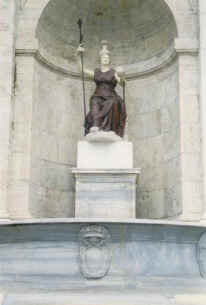|
|
 |
|
Campidoglio |
|
written
by sariah / 09.28.2005 |
|
|
| |
Function |
| |
| |

|
| http://www.ac-amiens.fr/ pedagogie/italien/ bibliotecaimmagini/romafoto/ campidoglio/campidoglio7p.JPG |
| Statue of Roma/Minerva |
| At the base of Palazzo Senatorio is Roma/Minerva who holds a globe, symbolizing Rome's power as the center of the world. |
| |
|
| |

|
| http://www.italycyberguide.com/ Geography/ cities/rome2000/ images/K3.jpg |
| Giant Order Columns on Palazzo dei Conservatori |
| Palazzo dei Conservatori and Palazzo Nuovo are across from one another and possess identical facades. On both, giant order columns that span two stories are present. |
| |
|
The design of the Campidoglio masterfully manipulates the flow of people from the lower level of busy streets, up the cordonata and through the square, leading up to the Palazzo Senatorio. The piazza is meant to be enjoyed by all Romans, and thus, is easily accessible from the streets below. The heavy axis deliniated by the Campidoglio’s symmetry runs from the center of the cordonata straight through the square, and directs viewers towards the Palazzo Senatorio. However, movement is impeded by the Statue of Marcus Aurelius, delaying progression from the top of the cordonata towards the Palazzo Senatorio. The stellate design encourages revolution around the statue. In addition, the entryways to the Palazzo Senatorio staircase force a diversion from the central axis because of their position away from the central axis of the square. Michelangelo’s purposeful direction of the viewer through the space emphasizes the importance of Palazzo Senatorio as the focal building of the Campidoglio, but also encourages the viewer to pause and focus his/her attention towards the statue of Marcus Aurelius.
When commissioning Michelangelo to redesign the Campidoglio, Pope Paul III had two specific goals in mind. First, he wanted the space to serve as an appropriately grand representation of Rome’s symbolic importance as the caput mundi or center of the world. Second, he wanted to clearly delineate the role of the Church in this long-standing seat of secular government.
Several architectural elements carryout Pope Paul III’s first goal of emphasizing the role of Rome as the center of the world. All of the previously described statues lining the ballistades and in the Palazzo Senatorio’s fountain represent historical symbolism that recalls the power of ancient Rome. As mentioned earlier, the river gods and Egyptian lions represent the geographical extent of Rome’s historical influence, and the coats of armor on the Cordanata ballistrade represent the spoils of Roman conquest. Additionally, the Statue of Minerva/Roma grasping the world in her hands symbolizes Rome’s hold on the world. More subtle is the gentle curve of the stellate paving pattern surrounding the Statue of Marcus Aurelius. This curve is designed to represent the shape of Earth exposed, and thus, Rome’s role as the center of global power. Finally, the strength of the vertical and horizontal lines in the building facades imparts a commanding presence to all three Palazzos.
There are three other main elements that focus on Pope Paul III’s desire to emphasize the power of the Church in secular governance. First, the placement of Marcus Aurelius in the center of the square was meant to imply the importance of Christianity in the Roman Empire. As stated earlier, this equestrian statue was long thought to be that of Constantine, the first Christian emperor, and thus, had special significance for the Paul III. Its identification as Marcus Aurelius occurred only several decades after Paul III’s death; therefore, its mistaken symbolism was probably shared by visitors to the Campidoglo for a corresponding period of time. Second, the base for the equestrian statue has a clear representation of Paul III’s crest, thus symbolizing the role of the Church on Capitoline Hill, the ancient and modern seat of secular government. Third, the entryway to Palazzo Senatorio was redesigned to directly face St. Peter’s Basilica. Originally, the entry to the Palazzo Senatorio was through the Forum. However, in Michelangelo’s redesign, he reversed the direction of main entry and exit, so that all senators moving into the Palazzo Senatorio would clearly see St. Peter’s in the Roman skyline. Paul III clearly sought to emphasize the connection between the secular and religious capitals of Rome.
|
| |
|
| |
|
|
 |
|

